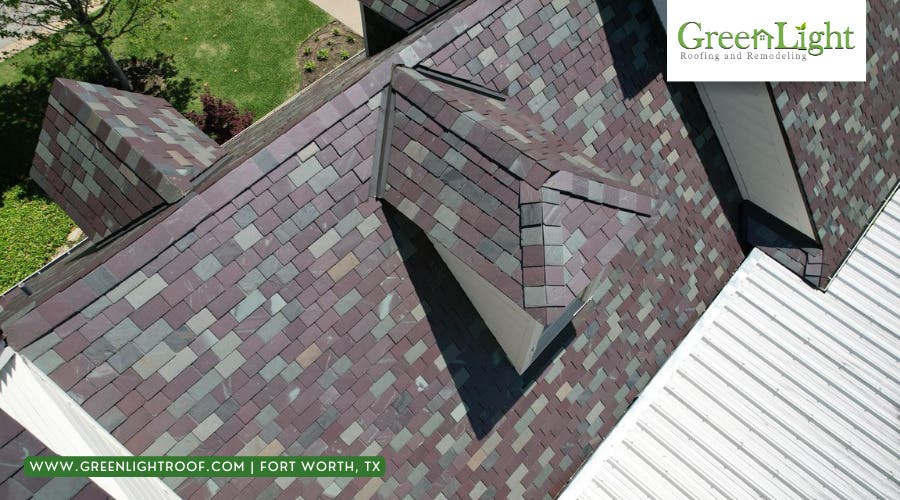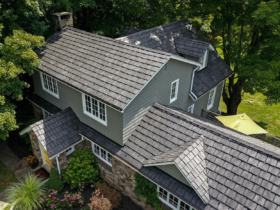Slate roofing is a premium roofing material made from natural slate rocks. It is known for its durability, longevity, and distinctive appearance.
Roofing with slate offers a combination of aesthetic appeal and exceptional performance, standing out as a choice for homeowners who want to invest in their property’s value and curb appeal. Not only does slate have a natural resistance to the elements, making it waterproof and fireproof, but it also comes in various colors and textures to match different architectural designs.
Its longevity is unparalleled, often lasting over a century, making it an eco-friendly option as it minimizes the need for replacement. Despite its higher upfront cost, slate roofing remains a top-tier option for its timeless beauty and life-long resilience, which can ultimately lead to cost savings over its extended lifespan.
The Legacy Of Slate Roofing
Roofs over our heads tell tales of the past, and none quite like slate roofing. Steeped in history, these stone shingles reveal a narrative of durability and elegance. Explore the journey of slate roofing, a craft that has sheltered generations and withstood the test of time.
Historical Significance
The use of slate as a roofing material dates back centuries. Due to its longevity and fire-resistant properties, slate became the material of choice for roofing across the world. Ancient structures in Europe showcase this legacy, with many still sporting their original slate roofs. Old world charm foundations are evident in cities like Madrid, Paris, and London, where slate roofs dominate historic districts, symbolizing wealth and status.
Geological Formation Of Slate
Slate forms over time from sedimentary clay or volcanic ash. Tremendous pressure and heat deep below the earth’s surface transform these raw materials into metamorphic rock. Miners extract this fine-grained rock from quarries. They then craft it into sheets used for roofing. Each piece of slate tells a story of millions of years of geological history. Regions famed for producing high-quality slate include Wales, the USA, and Spain, with each offering a unique color and texture to the architectural landscape.

Credit: m.facebook.com
Characteristics Of Slate
Understanding slate as a roofing material is crucial for making an informed choice. Its characteristics set it apart in durability, beauty, and variety. Let’s explore these distinctive traits.
Durability And Longevity
Slate roofs are synonymous with resilience. These natural stone tiles can withstand harsh weather conditions without losing integrity. Here are several reasons slate is a top-notch choice for long-lasting roofs:
- Resistant to fire: Slate doesn’t burn, offering enhanced safety against fire.
- Impervious to rot: Unlike wood, slate tiles do not decay over time.
- Low absorption rate: They absorb minimal moisture, averting frost damage.
With proper installation, slate roofs can protect buildings anywhere from 75 to 200 years.
Natural Beauty And Variety
Slate’s natural beauty is unmatched. It brings a unique, elegant appearance to any home. Each slate tile boasts a distinct texture and color blend, ensuring no two roofs are entirely alike. Here’s what adds to its aesthetic appeal:
| Characteristic | Description |
|---|---|
| Color Range | Available in greens, grays, blues, and purples, to suit various styles. |
| Texture Variations | From smooth to more rugged, textures can vary, offering different looks. |
| Shaping | Custom-cut shapes expand your architectural design possibilities. |
Slate’s color and texture may change slightly with weathering. Yet it always maintains its classic appeal. The robust material complements various architectural styles, from traditional to contemporary.
Slate Roofing Installation Process
The Slate Roofing Installation Process is a skilled task that transforms natural stone into a beautiful and durable roof. It involves precision and craftsmanship to ensure a long-lasting result. Understanding the process is essential for homeowners and builders alike.
Tools And Materials Needed
Having the right tools and materials is the first step to a successful slate roof installation. Here is what’s needed:
- Slate shingles
- Roofing nails
- Hammer or nail gun
- Slate cutter or ripper
- Roofing felt
- Battens
- Ladder and scaffolding
- Chalk line and measuring tape
Step-by-step Installation Guide
Installation of a slate roof is detailed but manageable. Follow these steps:
- Prepare the Roof: Make sure the surface is clean and flat. Install roofing felt to create a barrier.
- Batten Placement: Set battens horizontally across the roof for slate attachment.
- Start at the Bottom: Begin laying slates from the eaves, moving upward.
- Overlapping Slates: Ensure each slate overlaps the joint between the two below it.
- Securing the Slate: Use nails to secure slates, but do not overdrive. Slates should hang, not be tightly fixed.
- Alignment: Keep an eye on alignment. Use a chalk line for guidance.
- Trimming: Trim slates at the hips, valleys, and ridges to fit properly.
- Final Inspection: Check for evenness and secure all pieces firmly.
Benefits Of Choosing Slate
Thinking about a new roof? Slate roofing stands out. It is strong and beautiful. Homes and buildings with slate have a unique look. Let’s dive into why slate might be the perfect choice for your roof.
Weather Resistance And Insulation
Slate resists harsh weather. Snow, rain, or sun, slate can take it all.
- Long-lasting: It lasts over 100 years.
- Fireproof: It’s a smart choice in hot, dry areas.
- Low maintenance: Rarely needs repairs.
Slate keeps your home comfy. It insulates well. This means cooler summers and warmer winters inside.
Increase In Property Value
Slate adds curb appeal and value. It’s a high-quality roofing material that looks great and lasts. Here’s how it boosts property value:
| Elegance | Durability | Resale Value |
|---|---|---|
| Timeless beauty | Withstands decades | Goes up |
Homes with slate roofs attract buyers. They are willing to pay more for these homes.
Maintenance And Care Of Slate Roofs
Slate roofing brings a classic charm to any home. It’s crucial to keep it well-maintained. Proper care ensures lasting durability and aesthetic appeal. Let’s delve into how to keep your slate roofs in prime condition.
Routine Inspection And Cleaning
Regular checks play a vital role in maintaining slate roofs. They can quickly reveal any issues. Seek a professional or use a sturdy ladder and binoculars for safe self-inspection.
- Clear debris like leaves and branches.
- Inspect for damaged or missing slates.
- Look for signs of water damage under the roof.
Trim overhanging tree limbs to prevent damage. Ensure gutters and downspouts are free of blockages for proper drainage.
Dealing With Slate Repairs
If issues arise, address them swiftly to prevent further damage. Replacing slates requires precise technique.
| Step | Action |
|---|---|
| 1 | Remove damaged slates with a slate ripper. |
| 2 | Slide new slates into place carefully. |
| 3 | Secure them with copper nails and a slate hammer. |
Complete repairs under dry weather conditions. This ensures safety and effectiveness. For complex issues, consult a roofing professional with experience in slate.

Credit: www.newpro.com
Slate Roofing Compared To Other Materials
When choosing a roofing material, slate stands out for its durability and aesthetic appeal. Yet, understanding how it stacks against other materials is crucial. Each roofing type has distinct features, influencing homeowners’ choices based on cost, longevity, and environmental impact. Let’s break down slate roofing’s benefits and challenges compared to other popular materials.
Cost Analysis
Upfront Costs vs. Longevity: Slate roofing might seem pricier at first glance than options like asphalt shingles or metal roofing. But, the longevity of slate is unmatched, often lasting over a century. This makes it a cost-effective option in the long run.
Maintenance and Repair Expenses: Slate requires less frequent maintenance but can be more costly to repair due to its heavy nature and the skill required for installation and repair.
| Material | Initial Cost | Lifespan | Maintenance Cost |
|---|---|---|---|
| Slate | High | 100+ years | Lower Frequency, Higher Cost |
| Asphalt | Low | 15-30 years | Higher Frequency, Lower Cost |
| Metal | Medium | 40-70 years | Medium Frequency, Medium Cost |
Environmental Impact
Natural and Sustainable: Slate is a natural stone product, making it one of the most eco-friendly roofing materials. It does not emit pollutants during manufacturing and is completely recyclable.
Energy Efficiency: The thermal properties of slate help in maintaining home temperatures, thereby reducing energy consumption.
- Slate: Low carbon footprint, reusability
- Asphalt: High waste production, less durable
- Metal: Recyclable, moderate energy efficiency

Credit: premiumslatesuk.com
Frequently Asked Questions Of What Is Slate Roofing
What Are The Disadvantages Of A Slate Roof?
Slate roofs are expensive to install and require professional expertise. They’re also heavy, possibly demanding structural support. Fragility can lead to breakage if walked on. Repairing slate can be costly due to material and labor prices.
What Is Slate Roofing Made Of?
Slate roofing is made of natural slate, a fine-grained, metamorphic rock known for its durability and longevity. It’s cut into thin tiles for installation on roofs.
What Is The Biggest Problem With Slate Roofs?
The biggest problem with slate roofs is their high cost and the need for specialized installation by skilled professionals. Slate is also quite heavy, which can demand extra roof support.
Is A Slate Roof A Good Roof?
Yes, a slate roof is an excellent choice for roofing due to its longevity, durability, and timeless aesthetic appeal. It’s known for lasting over 100 years and can withstand harsh weather conditions.
Conclusion
Slate roofing stands as a testament to durability, beauty, and sustainability. This timeless material elevates homes with its natural elegance. Selecting slate means investing in a roof that may very well outlast the structure it protects. By choosing slate, homeowners embrace both history and longevity for their dwellings.






Leave a Reply